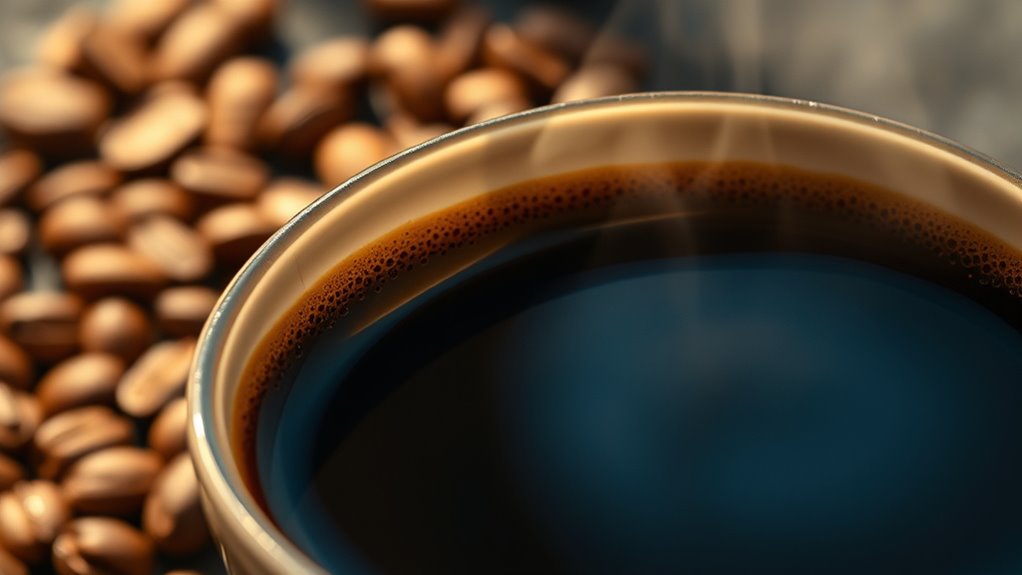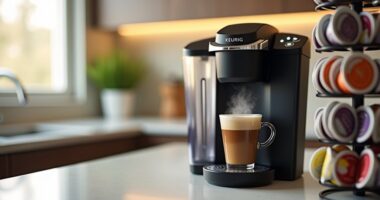If your espresso tastes super acidic, it might be due to your beans, brewing method, or roast level! Arabica beans and lighter roasts are known for that bright zing. Also, if you’re brewing too quickly, it might lead to unwanted sourness. And let’s not forget how altitude and soil impact those beans! Don’t worry, though—you can tweak your brew to mellow out that acidity. Stick around to find out more tips on perfecting your espresso!
At a Glance
- The type of beans used, especially Arabica, can contribute to a naturally bright acidity in your espresso.
- A short extraction time during brewing may lead to sour flavors, enhancing perceived acidity.
- Light roast levels preserve vibrant acids, while darker roasts can introduce bitterness instead of acidity.
- The coffee-to-water ratio in espresso is tighter, resulting in fewer acids compared to methods like drip coffee.
- Environmental factors, such as altitude and soil composition, can influence the acidity of the beans used in your espresso.
Factors Influencing Acidity in Espresso

When you take a sip of that rich, dark espresso, you might wonder why it sometimes hits your taste buds with a zing of acidity.
Well, it’s all about bean variety, processing method, roast level, and extraction time! Arabica beans usually have that bright kick, especially when grown high up in the mountains. If they’re wet-processed, they keep more of that zing. Light roasts? They’re like a party for your palate, preserving those vibrant acids. But watch out—if your extraction time’s too short, you might end up with a sour surprise. Additionally, the best Colombian coffee beans can offer a unique balance of acidity and flavor, enhancing your espresso experience.
Brewing Methods and Their Impact on Acidity
Ever noticed how that little shot of espresso can pack a punch of flavor while somehow feeling less acidic than your usual cup of drip coffee?
It’s all about espresso extraction and the brewing techniques you use. With shorter brew times—just 20 to 30 seconds—espresso keeps those pesky acids at bay compared to the 4 to 6 minutes of drip coffee.
Plus, the tighter coffee-to-water ratio means fewer acids make it into your cup. Additionally, using an automatic espresso machine can help achieve consistent extraction for a smoother flavor profile.
So, if you’re craving a smooth sip without the tang, it’s time to embrace that espresso magic and ditch the drip!
Cheers to delicious brews!
Chemistry Behind Espresso Acidity

Have you ever wondered why your espresso can taste so bright and vibrant while still feeling smooth? It’s all about the chemistry behind acidity balance!
When coffee beans roast, they break down and form various acids, like citric and malic acids, each adding unique flavor complexity. Lighter roasts keep more of these fruity notes, while darker ones might hit you with a sharp sourness.
It’s like a party in your cup! The magic happens when these acids interact, giving you that delightful taste experience without overwhelming bitterness. Additionally, the rich flavors of ground coffee play a significant role in enhancing the overall tasting experience.
Environmental Factors Affecting Acidity
You might be surprised to learn that the environment plays a huge role in your espresso’s acidity!
For starters, altitude effects make a big difference—coffee grown high up tends to be more acidic because of cooler temps and slower growth.
Then there’s soil composition; the minerals in the soil can shape how beans absorb nutrients, influencing their acidity too.
Plus, if the plants face water stress, that changes their chemical makeup. Additionally, the variety of coffee bean used can also influence acidity levels, further contributing to the overall flavor profile of your espresso.
Health Implications of Acidic Espresso

While sipping that rich, aromatic espresso might feel like a little slice of heaven, it’s important to contemplate what those tangy flavors mean for your health.
Sure, that acidity can give your gastrointestinal health a boost by protecting your gut lining, but don’t go overboard. Too much espresso could make your stomach grumble if you’ve got acid reflux.
Plus, those lively caffeine buzzes can raise your blood pressure a bit, especially if you’re not used to it.
But don’t fret! Moderate sipping can actually help your heart and keep those pesky digestive cancers at bay. Low acid coffee options are available for those who are sensitive to acidity. Cheers to balance!
Tips for Modifying Acidity in Your Espresso
If you’ve ever taken a sip of your espresso and thought, “Whoa, that’s a bit zippy for my taste!” don’t worry—there are plenty of ways to tone down that acidity.
Here are three easy tips:
Here are three simple ways to balance your espresso’s acidity and enhance its flavor!
- Adjust your grind size: Go finer to increase extraction, which helps mellow out those sharp flavors.
- Play with water chemistry: Use higher alkalinity water for smoother results; it can really make a difference!
- Experiment with extraction time: A longer shot pulls in more flavors and balances acidity nicely.
Additionally, using a quality coffee grinder can help ensure an even grind, which is essential for optimal extraction.
With a little tweaking, you’ll be sipping a delicious brew in no time!





